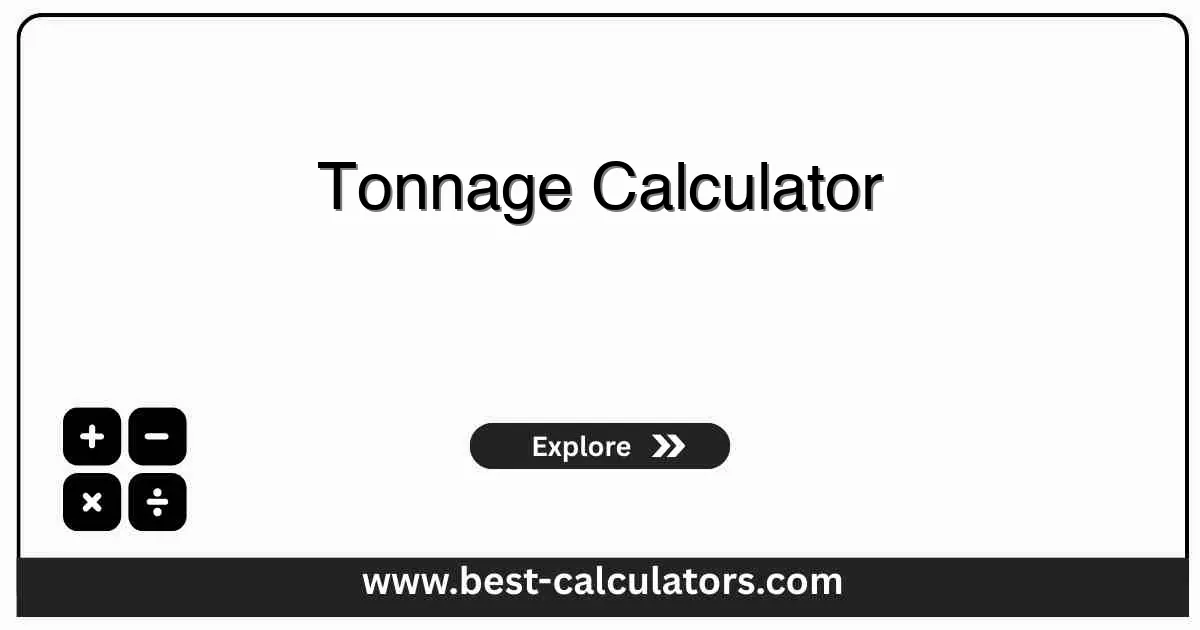Tonnage Calculator - Calculate Material Tons from Volume
Enter your project dimensions, select a material, or use a custom density to get instant volume and tonnage estimates for construction and DIY projects.
Tonnage Calculator
Results
Note: Results use industry-standard reference densities and unit conversions. Always confirm with your supplier and local design codes for critical structural applications.
What is a Tonnage Calculator?
A tonnage calculator is a professional tool that converts your project dimensions and material density into total weight in tons. It helps contractors, engineers, and DIY users order the right amount of bulk material with confidence.
This calculator works for rectangular coverage areas such as:
- Driveways and parking areas using gravel, asphalt, or road base.
- Slabs, footings, and pads poured with concrete.
- Landscaping beds and infill using soil, sand, crushed stone, or decorative rock.
- Backfill and sub-base layers beneath pavements and structures.
To validate your depth and coverage assumptions for concrete pours, use our Concrete Calculator to convert slab dimensions into precise cubic yard estimates.
For aggregate-based projects like driveways and walkways, explore our Gravel Calculator to refine volume, weight, and cost based on gravel-specific densities.
When working with crushed stone or erosion control, try our Crushed Stone Calculator to estimate graded stone requirements with waste factors.
For rip rap and heavy rock protection works, use our Rip Rap Calculator to determine armor stone tonnage for slopes and shorelines.
If you need a quick area-to-volume conversion before tonnage estimates, check our Square Feet to Cubic Yards Calculator to translate coverage into bulk volume accurately.
How the Tonnage Calculator Works
The calculator converts all dimensions to a consistent unit, computes volume, and multiplies by the selected material density to return tons.
Volume (yd³) = Volume (ft³) ÷ 27
Tons = Volume × Density / 2000
When using metric inputs or metric-based densities, the logic uses:
Tons = Volume (m³) × Density (kg/m³) ÷ 1000
The tool automatically chooses the correct formula based on your material preset or custom density unit, ensuring consistent, mathematically correct results.
Key Concepts Explained
Volume vs. Weight
Volume measures space (ft³, yd³, m³), while tonnage measures mass. Density links the two and depends on material type and compaction.
Material Density
Typical densities: gravel ~1.50 t/yd³, crushed stone ~1.60 t/yd³, sand ~1.35 t/yd³, soil ~1.10 t/yd³, concrete and asphalt ~2.40 t/m³.
Unit Consistency
All inputs are normalized internally. Mixing units is supported, but the math always works on consistent converted dimensions.
Extra/Waste Factor
Adding 5–15% extra compensates for compaction, uneven base, and handling losses, helping avoid short deliveries.
How to Use This Calculator
Enter Length
Measure the project length and select feet, meters, or yards based on your plan.
Enter Width
Measure the width of the coverage area in the same style and choose the unit.
Set Depth
Enter the layer thickness (in, ft, m, or yd) that matches your design requirement.
Pick Material
Choose a preset like gravel or concrete, or select custom density for other materials.
Add Extra %
Enter 5–15% extra if you want a safety margin for compaction and waste.
Review Tons
Click calculate to see volume and tonnage. Use the total tons value when ordering materials.
Benefits of Using This Tonnage Calculator
- • Accurate planning: Convert dimensions into reliable tonnage estimates using professional formulas.
- • Unit flexibility: Work in mixed metric or imperial units without manual conversion errors.
- • Material presets: Instantly apply typical densities for common construction materials.
- • Custom scenarios: Support for any special material via custom density input.
- • Reduced waste: Use the extra percentage to avoid costly under-ordering and unnecessary returns.
Factors That Affect Your Tonnage Results
1. Moisture and Compaction
Wet or heavily compacted material weighs more per cubic unit than dry, loose material, shifting actual tonnage.
2. Gradation and Void Ratio
Coarser aggregates with larger voids may require more tons for the same coverage compared to well-graded mixes.
3. Site Conditions
Uneven subgrades, slopes, and localized deep spots increase actual fill volumes beyond ideal calculations.
4. Measurement Accuracy
Small errors in length, width, or depth measurements are amplified over large areas and impact tonnage.
5. Supplier Practices
Bulk material is often sold by rounded loads. Always align your calculated tonnage with your supplier's load sizes.

Frequently Asked Questions (FAQ)
Q: How does the tonnage calculator work?
A: It converts your entered dimensions to volume, applies the selected or custom density, and outputs total tons. All unit conversions are handled automatically.
Q: What units does this tonnage calculator support?
A: Length and width support feet, meters, and yards. Depth supports inches, feet, meters, and yards. Results are shown in ft³, yd³, m³, and tons.
Q: Which materials can I estimate with this calculator?
A: Use presets for gravel, crushed stone, sand, soil, asphalt, and concrete, or enter a custom density for any bulk material.
Q: How accurate are the preset densities?
A: Presets are based on typical industry values. Actual densities may vary, so confirm with your supplier for critical applications.
Q: Should I include extra material in my order?
A: Yes. Adding 5–15% helps cover compaction, uneven subgrades, and handling losses. Use the extra percentage field to model this.
Q: Can I use this for structural design approval?
A: No. This tool is for estimation only. Always consult an engineer and follow local codes for structural design and load-bearing checks.